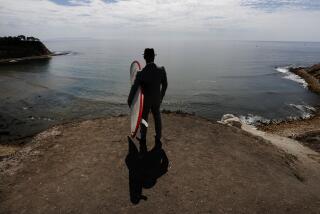Reliving the Wild Surf : Ventura: Some longtime wave-riders are preserving a piece of local history by opening a museum devoted to the sport.
- Share via
Riding waves of nostalgia, a group of aging Ventura surfers are the Big Kahunas behind a new museum to chronicle their beloved sport just a few steps from their favorite beach.
The graying gang of surf riders have donated wooden long boards, Hawaiian shirts and surfing posters to the small storefront building across from the Holiday Inn on the San Buenaventura State Beach promenade. The C-Street Surfing Museum is scheduled to open without fanfare on Sunday. A grand opening will follow.
“I was one of only three or four guys in the county who surfed,” said Ned Bartels of Ventura, 56, who first hit the waves with a balsa board more than 40 years ago. “It was a close-knit community.”
But then, he said, the movie “Gidget” came out in 1960. “It screwed up everything,” he said. “It went bonkers after that. There were 900 people on the beach. It popularized the whole thing and made it a way of life.”
Joyce Cantrell, the museum coordinator, said she was never really a part of the surfing culture. “I don’t even go near the water,” said Cantrell, a Faria Beach resident. “I don’t even put my feet in the water.”
She got involved only because of her husband, Jack, who, like Bartels, was one of the few surfers in the Ventura area in the 1950s.
As museum coordinator, Cantrell directs the hanging of photos, the arrangement of antique surfboards and selection of other memorabilia for display. The museum walls are adorned with surfboards dating back to the 1920s, photos of the best wave breaks in Ventura, Hawaiian shirts and framed posters of vintage surfing films. Plans for different exhibits and exchanges with other surfing museums are in the works. There are three other surfing museums in California--in Huntington Beach, Oceanside and Santa Cruz.
The museum’s opening exhibit will feature the work of Tom Morey, a surfing legend who revolutionized the sport in the early 1970s with the invention of the Morey Boogie Board. Morey made surfboards in Ventura in the 1960s.
The idea for a surfing museum was born in 1986 at a reunion of people who surfed long board at the bottom of California Street, or C Street as they like to call it, Cantrell said. A loose-knit organization was formed, but it languished for a few years. There was no official membership roster, just a mailing list of about a thousand people and 25 directors, Cantrell said.
“We have a surfer’s mentality here,” she said. “If the surf’s up, you surf--that’s a priority.”
Things got more serious about two years ago, and finally last August the Ventura City Council agreed to lease the 800-square-foot storefront at 342 S. California St. for $1 a year for two years.
Surfer Dan Pincetich, 45, a board member of the museum association and a former assistant city manager of Ventura, helped negotiate the lease with the city.
“The choice for the city was for a commercial venture or the museum,” Pincetich said. “But the museum will provide a nice amenity. They put the monkey on our back to perform, and we’re performing.”
Pincetich said the city hopes that the museum will add to the city’s appeal to tourists.
The immediate goal of the museum, Cantrell said, is to survive through the two-year lease.
Jack Cantrell, 63, started surfing in 1953 and continues to paddle through the breakers today. “The boards were pretty lousy in those days,” he said. “The first balsa boards were 11 feet long and weighed 44 pounds. Then they came out with foam boards and by 1962, the beaches got too crowded.”
Museum officials are encouraged by a resurgence of interest in long board surfing by middle-aged men who picked up their first boards in the 1960s.
Stan Fujii, president of the museum’s association and the owner of a Ventura surf shop, said other factors besides nostalgia make bigger boards popular with the older surfers. “The long boards are more versatile,” Fujii said. “They can surf in a lot of different surf conditions.”
“As you get older, you like more comfort,” he said. “With cars, people go from a Chevy to a Cadillac. Price is less of a consideration. They’re looking for something to (help them) relax, when they want to relax.”
More to Read
Sign up for The Wild
We’ll help you find the best places to hike, bike and run, as well as the perfect silent spots for meditation and yoga.
You may occasionally receive promotional content from the Los Angeles Times.






